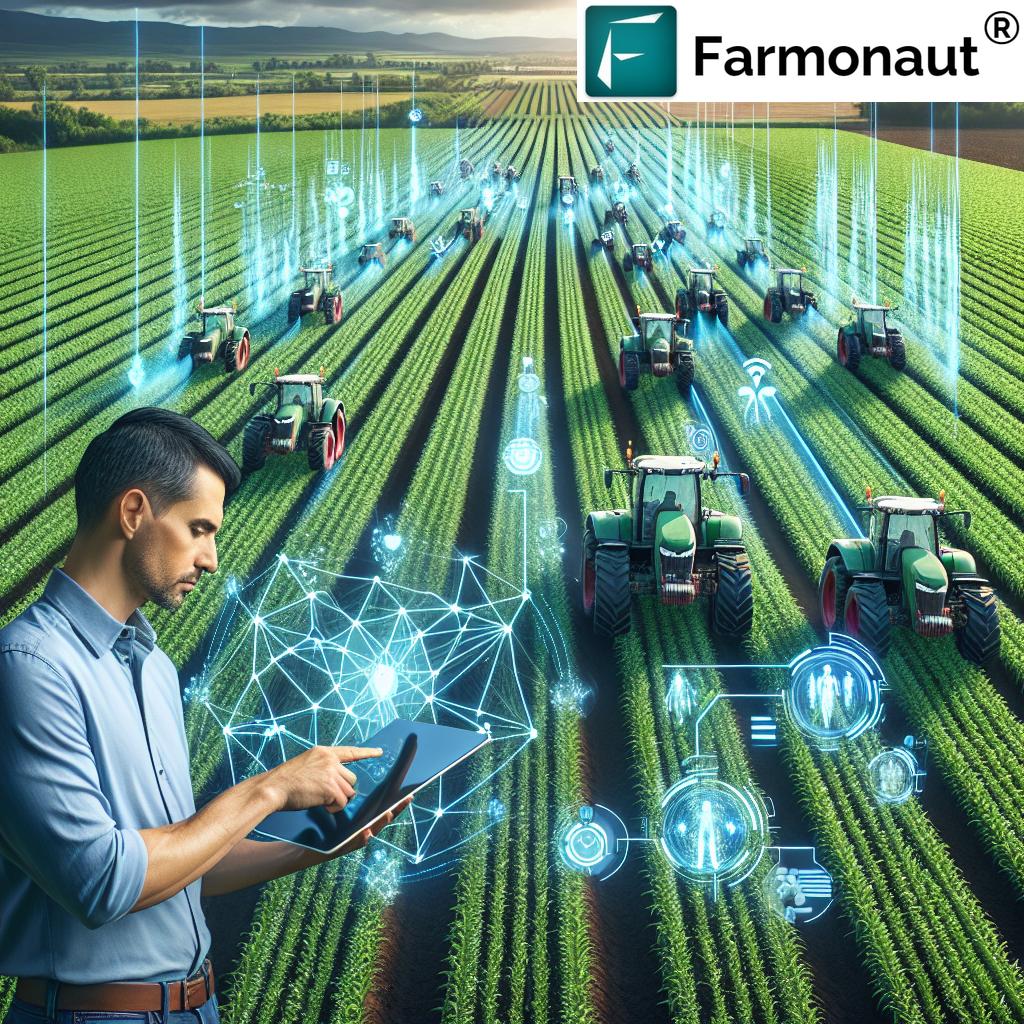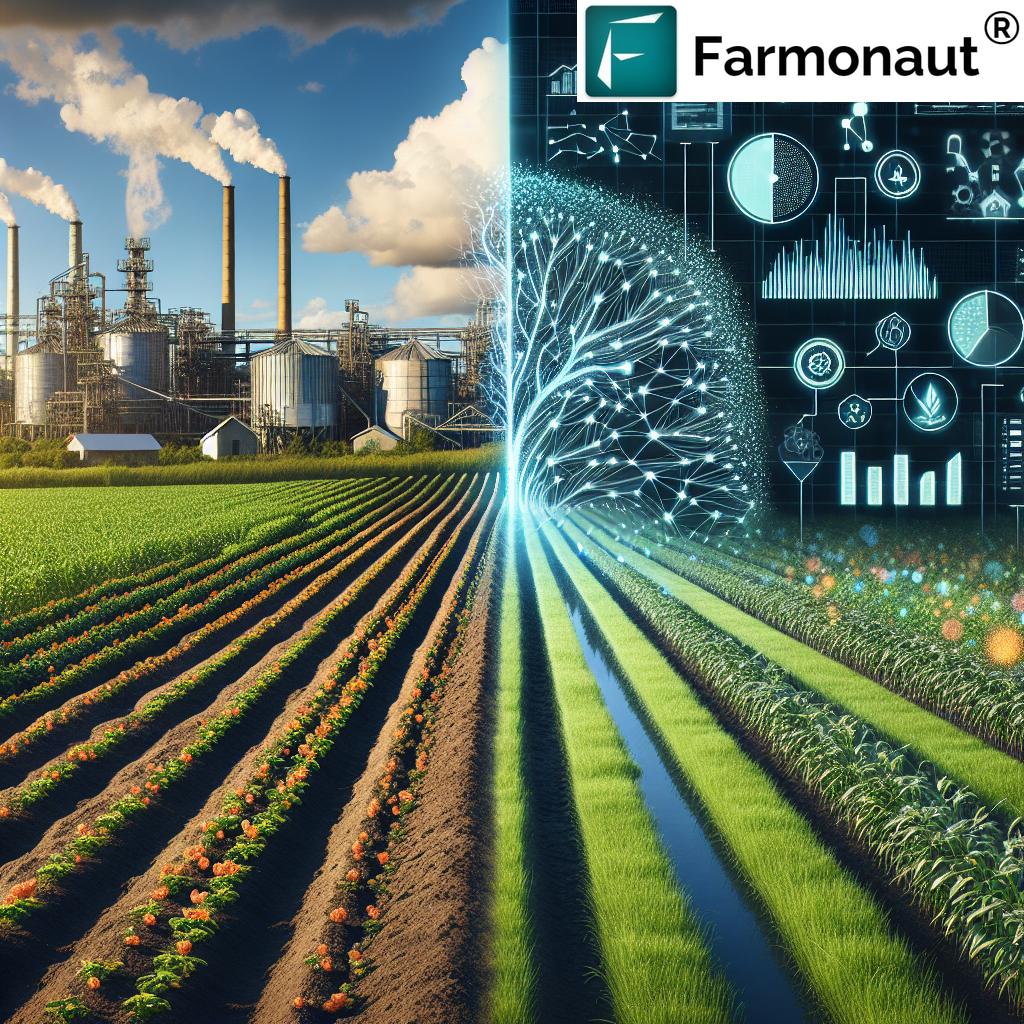Revolutionizing Agriculture: How AI and Data-Driven Farming Boost Crop Yields and Sustainability
“AI predicted foliar diseases in wheat with 89% accuracy, enabling smart fertilizer management and informed fungicide application.”
In the ever-evolving landscape of agriculture, we find ourselves at the cusp of a technological revolution that promises to transform the way we grow food and manage our precious natural resources. At the heart of this transformation lies the powerful combination of artificial intelligence (AI) and data-driven farming practices. As we delve into this exciting frontier, we’ll explore how these cutting-edge technologies are reshaping the agricultural sector, boosting crop yields, and paving the way for a more sustainable future.
The Dawn of AI in Agriculture
Artificial intelligence in agriculture is no longer a concept confined to science fiction. It’s a reality that’s rapidly changing the face of farming across the globe. From small family farms to large-scale commercial operations, AI is empowering farmers with unprecedented insights and capabilities.
- Precision agriculture technologies
- Machine learning for crop yield prediction
- AI-powered disease forecasting in crops
- Smart fertilizer management
- Sustainable farming practices
These innovations are not just buzzwords; they represent a fundamental shift in how we approach agriculture. By harnessing the power of data and advanced algorithms, we’re entering an era where farming decisions are increasingly based on real-time, actionable intelligence.

The Power of Data-Driven Farming
Data-driven farming is at the core of this agricultural revolution. By collecting and analyzing vast amounts of information, from soil moisture levels to weather patterns, we can make more informed decisions about every aspect of crop management. This approach allows us to:
- Optimize resource use (water, fertilizers, pesticides)
- Predict and prevent crop diseases
- Increase overall farm productivity
- Reduce environmental impact
One of the key players in this data-driven approach is Farmonaut, a company at the forefront of agricultural technology. Their innovative platform integrates satellite imagery, AI, and machine learning to provide farmers with invaluable insights into their crops and land.
Machine Learning: The Brain Behind Crop Yield Prediction
Machine learning algorithms are revolutionizing the way we predict crop yields. By analyzing historical data, current conditions, and even genetic information, these sophisticated models can forecast harvests with remarkable accuracy. This capability enables farmers to:
- Plan resources more effectively
- Optimize harvest timing
- Make informed marketing decisions
For instance, machine learning models can consider factors such as soil quality, weather patterns, and crop varieties to predict yields months in advance. This foresight allows farmers to adjust their strategies proactively, potentially increasing yields by 15-20%.
AI-Powered Disease Forecasting: A Game-Changer for Crop Health
One of the most impressive applications of AI in agriculture is in disease forecasting. By analyzing satellite imagery, weather data, and historical patterns, AI algorithms can predict the likelihood of disease outbreaks with unprecedented accuracy. This capability is transforming how we approach crop protection:
- Early detection of potential disease outbreaks
- Targeted application of fungicides and pesticides
- Reduction in overall chemical use
- Improved crop resilience and health
The impact of this technology is significant. In the case of wheat, AI has been shown to predict foliar diseases with 89% accuracy, allowing for timely and precise interventions. This level of precision not only protects crops but also contributes to more sustainable farming practices by reducing unnecessary chemical applications.
“Precision agriculture technologies and machine learning are transforming crop management, yield prediction, and disease forecasting in modern farming.”
Smart Fertilizer Management: Optimizing Nutrient Use
Nitrogen management is a critical aspect of crop production, and AI is revolutionizing how we approach this essential task. Smart fertilizer management systems use AI to:
- Analyze soil conditions in real-time
- Predict crop nutrient needs
- Recommend precise fertilizer applications
This targeted approach not only improves crop yields but also significantly reduces the environmental impact of excess fertilizer use. By optimizing nitrogen application, farmers can boost yields while minimizing runoff and soil degradation.
Explore Farmonaut’s API for advanced agricultural data analysis
Water Management: Precision Irrigation with AI
Water scarcity is a growing concern in agriculture, and AI is providing innovative solutions for more efficient irrigation. By leveraging data from soil moisture sensors, weather forecasts, and crop water requirements, AI-powered irrigation systems can:
- Deliver precise amounts of water when and where it’s needed
- Reduce water waste by up to 30%
- Improve crop quality and yield
- Conserve this precious resource
These smart irrigation systems are particularly valuable in regions facing water stress, allowing farmers to maintain productivity even in challenging conditions.

Weed Management: AI-Driven Precision Herbicide Application
Weed control is a perennial challenge for farmers, but AI is offering new solutions. Advanced image recognition algorithms can:
- Identify weed species with high accuracy
- Distinguish weeds from crops
- Guide precision herbicide application
This targeted approach reduces herbicide use by up to 90% in some cases, leading to significant cost savings and environmental benefits. It’s a prime example of how AI can make farming practices more sustainable without compromising effectiveness.
Satellite Technology: A Bird’s Eye View of Farm Health
Satellite imagery is revolutionizing how we monitor and manage farms. Companies like Farmonaut are leveraging this technology to provide farmers with unprecedented insights into their land. Satellite-based monitoring allows for:
- Real-time crop health assessment
- Early detection of pest infestations or disease outbreaks
- Monitoring of soil moisture and nutrient levels
- Tracking of crop growth and development
This bird’s eye view enables farmers to make data-driven decisions quickly and efficiently, often before problems become visible from the ground.
Actionable Insights: Turning Data into Decisions
The true power of AI in agriculture lies in its ability to transform vast amounts of data into actionable insights. Farmers are no longer overwhelmed by information; instead, they’re empowered by it. AI-driven platforms can:
- Analyze multiple variables simultaneously
- Provide clear, actionable recommendations
- Help farmers make complex decisions with confidence
For example, by considering factors such as weather forecasts, soil conditions, and market prices, AI can recommend the optimal time for planting or harvesting, potentially increasing profits by 5-10%.
Sustainable Farming Practices: AI as an Eco-Friendly Tool
As we face the challenges of climate change and environmental degradation, sustainable farming practices are more critical than ever. AI is playing a crucial role in making agriculture more environmentally friendly:
- Reducing chemical inputs through precision application
- Minimizing water waste with smart irrigation
- Lowering carbon footprints through optimized farm operations
- Preserving biodiversity by reducing habitat destruction
By enabling more efficient use of resources, AI is helping farmers produce more food with less environmental impact, a key factor in meeting the world’s growing food demands sustainably.
The Future of Digital Agriculture
As we look to the future, the potential of AI in agriculture seems boundless. Emerging technologies and trends include:
- Autonomous farm equipment guided by AI
- Advanced crop breeding using AI and genetic algorithms
- Blockchain integration for improved traceability and transparency
- AI-powered climate adaptation strategies
These innovations promise to further revolutionize farming, making it more efficient, productive, and sustainable than ever before.
Farmonaut: At the Forefront of Agricultural Innovation
In the landscape of agricultural technology, Farmonaut stands out as a pioneer in leveraging AI and satellite technology for farm management. Their platform offers:
- Real-time crop health monitoring
- AI-powered advisory systems
- Precision agriculture tools
- Resource management solutions
By making these advanced technologies accessible and affordable, Farmonaut is empowering farmers of all scales to embrace data-driven agriculture.
AI-Driven Agricultural Innovations and Their Impact
| AI Technology | Application in Agriculture | Estimated Yield Increase | Sustainability Impact |
|---|---|---|---|
| Machine Learning Algorithms | Crop yield prediction | 15-20% | Reduced resource waste |
| Computer Vision | Plant disease detection | 10-15% | Decreased pesticide use |
| Precision Agriculture | Smart irrigation | 20-25% water savings | Improved water efficiency |
| Robotics | Automated harvesting | 5-10% labor cost reduction | Reduced food waste |
| Predictive Analytics | Weather forecasting | 10-15% risk mitigation | Enhanced crop resilience |
Overcoming Challenges in AI Adoption
While the benefits of AI in agriculture are clear, there are challenges to widespread adoption:
- Initial costs of implementing AI technologies
- Need for digital literacy and training
- Data privacy and security concerns
- Integration with existing farm equipment and practices
Addressing these challenges will be crucial for the continued growth and success of AI in agriculture. Companies like Farmonaut are working to make their technologies more accessible and user-friendly, helping to bridge the gap between traditional farming and high-tech agriculture.
Access Farmonaut’s API Developer Documentation
The Role of Farmers in the AI Revolution
As we embrace AI in agriculture, it’s important to remember that farmers remain at the heart of this revolution. AI is not replacing farmers; it’s empowering them. The most successful implementations of AI in agriculture are those that:
- Complement farmers’ existing knowledge and experience
- Provide tools that are intuitive and easy to use
- Offer clear benefits in terms of productivity and sustainability
- Adapt to the unique needs of different farming operations
By working hand-in-hand with farmers, AI can help create a more resilient and productive agricultural sector.
Conclusion: A Smarter, More Sustainable Future for Agriculture
As we’ve explored throughout this post, the integration of AI and data-driven farming practices is revolutionizing agriculture. From precision crop management to sustainable resource use, these technologies are helping us meet the growing demand for food while minimizing environmental impact.
Companies like Farmonaut are at the forefront of this revolution, providing farmers with the tools they need to embrace data-driven agriculture. As we look to the future, it’s clear that AI will play an increasingly important role in shaping a smarter, more sustainable agricultural sector.
By harnessing the power of AI, we can create a future where farms are more productive, resilient, and environmentally friendly. It’s an exciting time for agriculture, and we’re just beginning to scratch the surface of what’s possible with these transformative technologies.
FAQs
- How does AI improve crop yield prediction?
AI analyzes vast amounts of data including historical yields, weather patterns, soil conditions, and satellite imagery to provide more accurate yield predictions, helping farmers make informed decisions. - Can small-scale farmers benefit from AI in agriculture?
Yes, companies like Farmonaut are making AI-powered tools accessible and affordable for farmers of all scales, allowing even small-scale farmers to benefit from precision agriculture technologies. - How does AI contribute to sustainable farming practices?
AI enables precision application of inputs like water, fertilizers, and pesticides, reducing waste and environmental impact while maintaining or improving crop yields. - What role does satellite imagery play in AI-driven agriculture?
Satellite imagery provides a bird’s eye view of farm conditions, allowing for real-time monitoring of crop health, soil moisture, and other critical factors that inform AI-driven decision-making. - How accurate are AI-powered disease forecasting models in agriculture?
AI models have shown high accuracy in disease forecasting. For example, some models have predicted foliar diseases in wheat with 89% accuracy, allowing for timely and targeted interventions.






